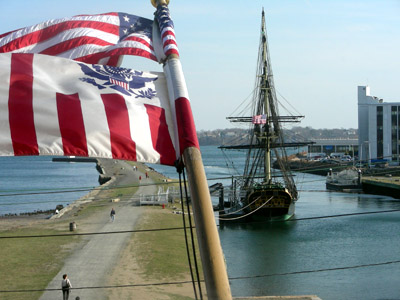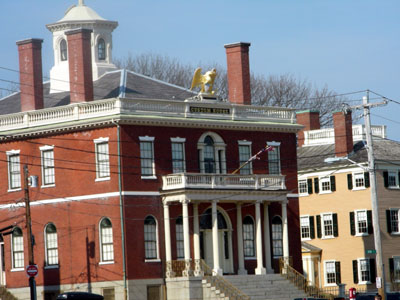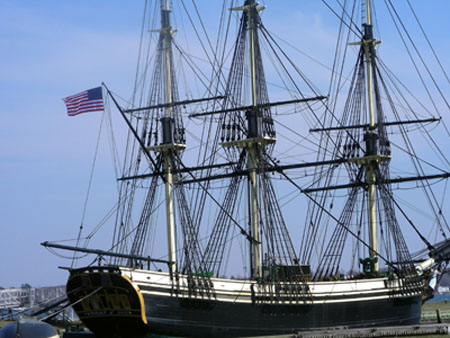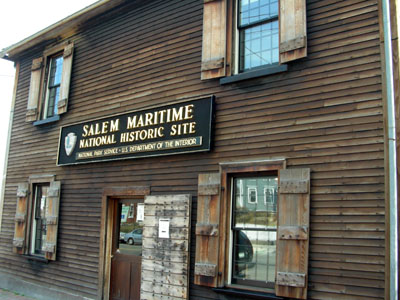
Salem is small town with big reputation
SALEM, Mass. — Nestled in the northeast sector of historic Massachusetts there is a small town with a big reputation. It may have a population of fewer than 40,000 people, but with the help of history books and blockbuster films, we have all been there.
Tales of witches’ brew and blueberry ale flow from this harbor town to the rest of the world. Salem, Mass., is its name and shipping was its game.
Perhaps as interesting as the tales of the Maritime Museum and its inhabitants is the journey to get there. Just a jaunt on the underground, an hour-long bus ride, a half-mile walk and a 45-minute trek from anywhere in Boston, getting to Salem requires at least a chocolate croissant and a specialty tea on Derby Street.
 |
Salem harbor and the Friendship of Salem, a tall ship docked in the port as seen from the second floor of the Custom House (Photo by Skylar Zwick). |
If you find yourself lost wandering the bewitching streets of Salem, don’t be surprised if you ask for directions and no one knows where you’re going. Despite the air of familiarity in Salem, most of the people seem just as unfamiliar with the surroundings as you are.
Once you’ve found your way to the Salem Maritime National Historic Site, you’ll be instantly transported back to a time when Salem was the center of the maritime trading industry and the home of Elias Derby, the first known millionaire in America.
In the 18th and 19th centuries, Salem housed 50 wharfs and more than 150 ships. It was the major port of call for international trade between America and the East Indies. Ships like Friendship of Salem took 15 to 20 men, as young as 19, away to exotic ports of call for years at a time.
“Sailing was like being in prison with the added threat of drowning,” quipped the tour guide Martin Fucio. If sailors survived the threats of disease, they could become wealthy, famous members of the town after making only a few trips and trading “the simple (shoes, dried beef and roof tiles) for the exotic,” like coffee, sugar, pepper, cotton, silk, nutmeg, tea and cinnamon, Fucio said.
Along the tour, visitors will “meet” the famous men that made American history and industry what it is today. One of the first entrepreneurs, Nathaniel Bowdich, sold a dozen pairs of shoes for 300 percent profit.
 |
The Custom House at Salem Maritime National Historic Site (Photo by Skylar Zwick). |
Bowditch returned a rich man, at the age of 22, after only one voyage at sea. Later, he found more than 8,000 errors in British navigation tables. His correction became known as celestial navigation, a sailing technique that is still used today.
The son of a sailor, Nathaniel Hawthorne, is also integral to the historic tour. As surveyor of Customs, Hawthorne was relegated to the Custom House where, as legend has it, he stumbled across a mailing box while poking around the attic.
The box contained the fine stitched scarlet ‘A’ enveloped in a scripture that unraveled the story of Hester Prynne. Along the tour of the custom house visitors can find out the truth behind the legend and even pay a visit to Hawthorne’s office.
Derby, Bowditch and Hawthorne are not the only names you’ll learn during the two hour tour. With the help of guides, you’ll be introduced the architecture, culinary styles, art, fashion and everyday habits from centuries past through tours of restored homes and archeological digs. Wall hangings and paintings will awaken your senses to the moral state of the time. Keep your eyes peeled, however, you might just spot some out of place modern touches.
As tour guides bring you through the 18th, 19th and 20th centuries you’ll quickly discover that things really haven’t changed. America is still, essentially, a barter economy. We just use dollars rather than shoes or dried beef. We still ship out common goods and import the exotic. Just the same, there are still a few business men, like Bill Gates, that will prosper like the Elias Derbys of yesteryear. Today, the Derby family would be worth $16.2 billion, roughly 40 percent that of Gates.
Tour guides Victory and Fucio say that their favorite parts of tour are the “visitors who as well-founded questions” and “when people come to the realization that the stuff they buy at Wal-Mart that says ‘made in China’ is part of a trade pattern that’s as old as the country itself.”
They really are not far from the truth.
Though Salem may too shallow to still be a major port of call, it set the precedent that created a nation and the strongest economy in the world.
So bring your walking shoes and your curiosity to the Salem Maritime Museum, where there is no boundary between then and now.
 |
The Friendship of Salem (Photo by Skylar Zwick). |
If You Go
Salem Martime National Historic Site
- Hours: 9 a.m. to 5 p.m. (the last tour of the day begins at 2:30 p.m.).
- Call ahead as the ship or homes may be closed due to weather, season or maintenance.
- Admission: $5 per person (includes the tours of the Derby House, the Narbonne House and the Friendship of Salem).
Before You Go
- Get detailed directions from your home / hotel.
- From Boston– take the Orange Line North to Haymarket, bus #455 or #450 to Salem rail then backtrack from the depot to Derby Street.
- Remember: Buses to Salem Depot take correct change only for the $3.45 fare.
- Spend the day in Salem and visit other attractions including the famous House of Seven Gables or the Salem Witch Village.
- Eat in one of Salem’s fine dining establishments, like Cilantros, or at the local Salem Brew House or Brother’s Deli & Restaurant.
| The Welcome Center of the Salem Maritime National Historic Site (Photo by Skylar Zwick). |  |

Comments are Closed